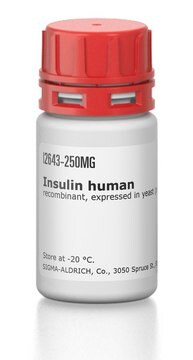11376497001
Roche
Insulina human
recombinant (yeast)
Sinónimos:
Insulin human
About This Item
Productos recomendados
Quality Level
sterility
non-sterile; 0.2 μm filtered
assay
>98% (SDS-PAGE)
form
lyophilized (clear, colorless solution after reconstitution)
mol wt
5,700 Da
packaging
pkg of 100 mg
manufacturer/tradename
Roche
technique(s)
cell culture | mammalian: suitable
impurities
<0.1 EU/μg endotoxin (LAL test)
solubility
water: soluble
UniProt accession no.
storage temp.
2-8°C
InChI key
PBGKTOXHQIOBKM-FHFVDXKLSA-N
Gene Information
human ... INS(3630)
¿Está buscando productos similares? Visita Guía de comparación de productos
General description
Specificity
Application
Biochem/physiol Actions
Other Notes
Quality
Note: 1 EU corresponds to 0.1ng
Sequence
Unit Definition
Physical form
Preparation Note
Recommended concentration for serum-free cell culture is 1-10 μg/ml.
The concentration of insulin required for stimulation of cell growth in almost all cases is extraordinarily high compared with the physiological concentration. Insulin may be mimicking insulin-like growth factors (IGFs, somatomedins) for some cell lines, and high insulin concentrations may be necessary to occupy receptors which have a high affinity for IGFs and a lower affinity for insulin.
Working solution: Dissolve Insulin, human, recombinant (100 mg or 500 mg), in sterile, double-dist. water (final concentration: 10 mg/ml).
Storage conditions (working solution): -15 to -25 °C
The reconstituted, undiluted solution is stable at -15 to -25 °C.
Note: Avoid repeated freezing and thawing.
Reconstitution
also commonly purchased with this product
wgk_germany
nwg
flash_point_f
Not applicable
flash_point_c
Not applicable
Certificados de análisis (COA)
Busque Certificados de análisis (COA) introduciendo el número de lote del producto. Los números de lote se encuentran en la etiqueta del producto después de las palabras «Lot» o «Batch»
¿Ya tiene este producto?
Encuentre la documentación para los productos que ha comprado recientemente en la Biblioteca de documentos.
Los clientes también vieron
Nuestro equipo de científicos tiene experiencia en todas las áreas de investigación: Ciencias de la vida, Ciencia de los materiales, Síntesis química, Cromatografía, Analítica y muchas otras.
Póngase en contacto con el Servicio técnico











